This week EFSP follows the world’s leading international silent-film festival, Le Gionate del Cinema Muto in Pordenone in Northern Italy. For the last festival day, we chose for a post on stunningly beautiful and highly photogenic Billie Dove (1903-1997), one of the most popular Hollywood actresses of the 1920s. She was dubbed 'The American Beauty', after the title of one of her films. In Pordenone, her film Careers (John Francis Dillon, 1929) is shown in the programme Cineteca Italiana 70.

Austrian postcard by Iris-Verlag, no. 5839. Photo: First National-Film.

French postcard by Cinémagazine-Edition, Paris, no. 313.
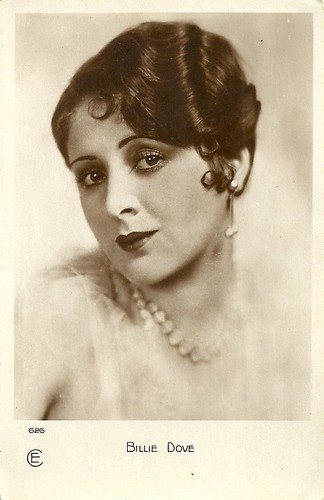
French postcard by Editions Cinémagazine, no. 626.

German postcard by Ross Verlag, no. 4364/1, 1929-1930. Photo: Defina / First National Pictures. Publicity still for Careers (John Francis Dillon, 1929).

German postcard by Ross Verlag, no. 5166/4, 1930-1931. Photo: First National-Film / Defina.
Billie Dove was born Bertha Bohny in 1903 in New York to Charles and Bertha (née Kagl) Bohny. Her parents were immigrants from Switzerland. Her brother, Charles, later became a cameraman in Hollywood. Bertha was educated in private schools in Manhattan. Her parents were Lutheran and their church organised sports events; the girls on the basketball team called her "Billie". As a teen, she worked as a model to help support her family.
Kevin Brownlow in his obituary in The Independent: "Billie was an exceptionally beautiful girl, and was in great demand as a model by such eminent artists as Charles Dana Gibson, Howard Chandler Christy and James Montgomery Flagg, who called her 'The Dove' because she was so lovely yet so shy. 'Billie Dove' soon became her professional name."
At age fourteen, she was hired by Florenz Ziegfeld to appear in his Ziegfeld Follies Revue between 1918 and 1920. A neighbour worked as an extra at Fort Lee, across the Hudson from New York City, and Billie's mother had her also registered at the film studios. One of her first appearances was in the Mabel Normand picture Joan of Plattsburg (William Humphrey, George Loane Tucker, 1918).
Billie also served as a dancing replacement in Ziegfeld's Broadway show Sally, (1921) which headlined Marilyn Miller. She legally changed her name to Lillian Bohny in the early 1920s. Gary Brumburgh at IMDb: "A burgeoning affair between Dove and Ziegfeld prompted Ziegfeld's wife Billie Burke to arrange work for the young starlet in Hollywood films."
At age nineteen, Billie had her first Hollywood contract with Metro, where she began appearing in such silent films as the comedy Get-Rich-Quick Wallingford (Frank Borzage, 1921), and Polly of the Follies (John Emerson, 1922), starring Constance Talmadge. Golden Silents: "Billie's roles were mainly decorative in the early years, but female director Lois Weber gave Billie some choicer roles to play in some of her better scripted films for Universal, and director Alexander Korda provided the same for films with First National."
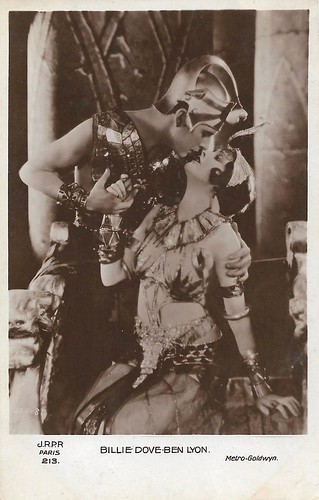
French postcard by J.R.P.R., no. 213. Photo: Metro-Goldwyn. Ben Lyon and Billie Dove in The Tender Hour (George Fitzmaurice, 1927). NB. The film was a First National production, not MGM.
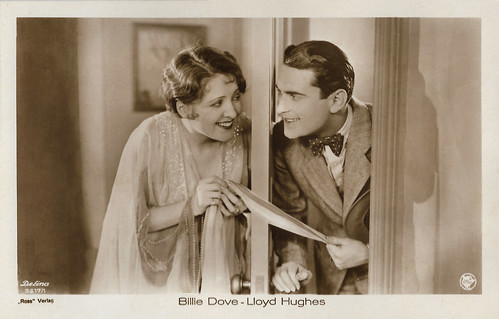
German postcard by Ross Verlag, no. 3217/1, 1928-1929. Photo: Defina / First National. Billie Dove and Lloyd Hughes in An Affair of the Follies (Millard Webb, 1927).
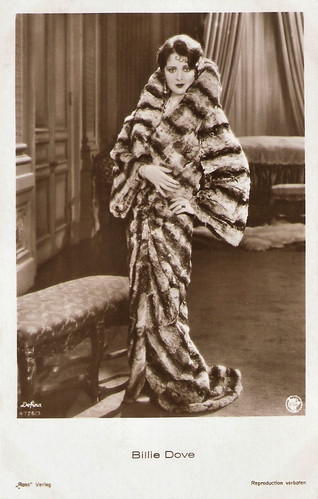
German postcard by Ross Verlag, no. 4726/3, 1929-1930. Photo: Defina / First National. Publicity still for The Stolen Bride (Alexander Korda, 1927).
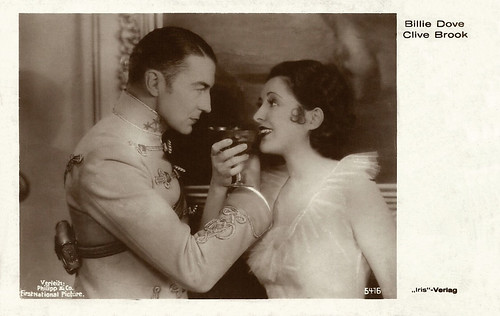
Austrian postcard by Iris Verlag, no. 5416. Photo: Verleih: Philipp & Co. / First National. Publicity still of Clive Brook and Billie Dove in Yellow Lily (Alexander Korda, 1928).
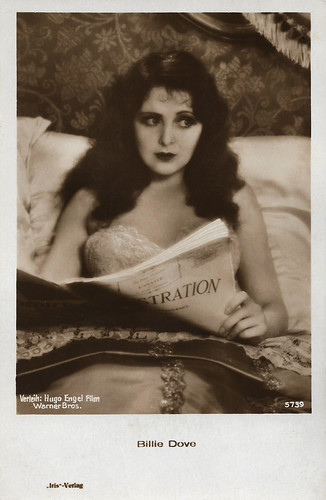
Austrian postcard by Iris-Verlag, no. 5739. Photo: Verleih Hugo Engel Film / Warner Bros. Publicity still for Adoration (Frank Lloyd, 1928).

French postcard by Europe, no. 622. Photo: Arta-Film / First National. Publicity still for The Man and the Moment (George Fitzmaurice, 1929).
Billie Dove had a leading role in All the Brothers Were Valiant (Irvin Willat, 1923) with Malcolm McGregor and Lon Chaney. She married the director of this film, Irvin Willat, in 1923.
Dove was dubbed 'The American Beauty', after her film The American Beauty (Richard Wallace, 1927), and at the end of the 1920s she was voted, with Clara Bow, as America's most popular actress. She appeared opposite Douglas Fairbanks in the smash hit Technicolour film The Black Pirate (Albert Parker, 1926), and played Rodeo West in The Painted Angel (Millard Webb, 1929). She transitioned to sound pictures smoothly and First National extended her contract. Multi-talented Billie was also a singer, a poet, a painter, and an aeroplane pilot. She had a huge legion of male fans, including the then 22-years-old multi-millionaire industrialist, movie producer and aviation enthusiast Howard Hughes.
Kevin Brownlow: "In 1930, in one of the most extraordinary transactions in Hollywood history, Hughes paid Willat $325,000 in thousand-dollar bills to give Billie a divorce. 'I begged Howard not to,' said Billie Dove, 'but there was nothing I could do once he gave the money to Irvin. I felt like I'd been bought and sold.'" She had a three-year romance with Hughes and was engaged to marry him, but she ended the relationship without ever giving cause. Billie Dove cited in The Independent: "It had nothing to do with any man and nothing to do with any woman - it was really such a tiny thing that you wouldn't believe it if I told you."
Hughes is said to have regarded her as the love of his life and they remained on friendly terms. He cast her in his films The Age for Love (Frank Lloyd, 1931), an embarrassing flop, and Cock of the Air (Tom Buckingham, 1932). The Hays Office found the latter too risque and insisted on savage and damaging cuts, and this film flopped as well. Her last film was Blondie of the Follies (Edmund Goulding, 1932) with Marion Davies.
In 1933, she married wealthy rancher and real estate developer Robert Alan Kenaston, a marriage that lasted for 37 years. The couple divorced in 1970 and he died three years later. The couple had a son, actor Robert Alan Kenaston, Jr., who was married to actress Claire Kelly, and an adopted daughter, Gail. In 1934, Dove retired from the screen to raise her family.
Aside from an unbilled bit part of a nurse in Diamond Head (Guy Green, 1963) with Charlton Heston, Dove never returned to the cinema. In the 1970s, Billie had a brief third marriage to architect John Miller, which ended in divorce. She spent her retirement years in Rancho Mirage before moving into the Motion Picture & Television Country House and Hospital in Woodland Hills, California where she died of pneumonia on New Year's Eve 1997, aged 94.

French postcard by Europe, no. 317. Photo: Mercure Film.
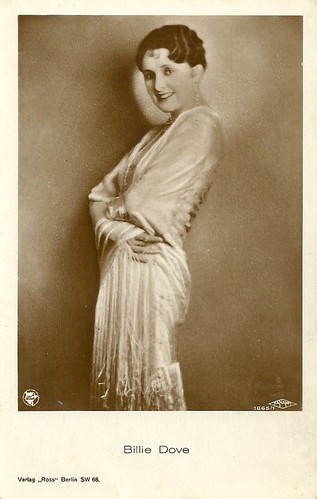
German postcard by Ross Verlag, no. 1865/1, 1927-1928. Photo: Fanamet / First National.
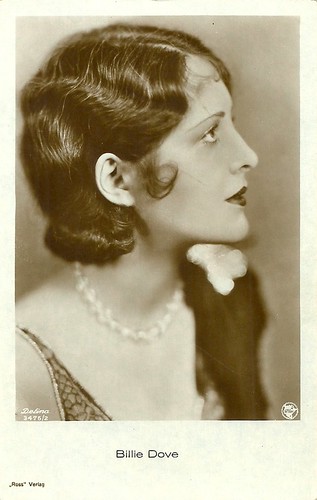
German postcard by Ross Verlag, no. 3476/6, 1928-1929. Photo: Defina / First National.
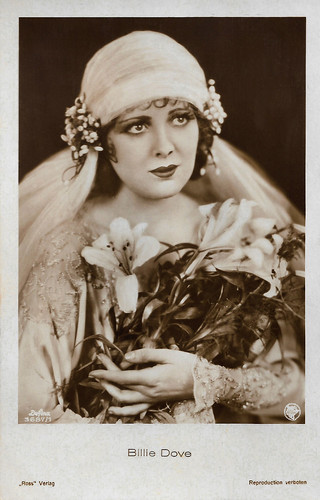
German postcard by Ross Verlag, no. 3687/1, 1928-1929. Photo: Defina / First National Pictures.

German postcard by Ross Verlag, no. 4364/2, 1929-1930. Photo: Defina / First National Pictures.
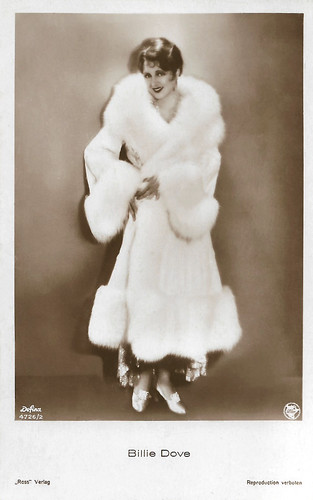
German postcard by Ross Verlag, no. 4726/2, 1929-1930. Photo: Defina / First National Pictures.
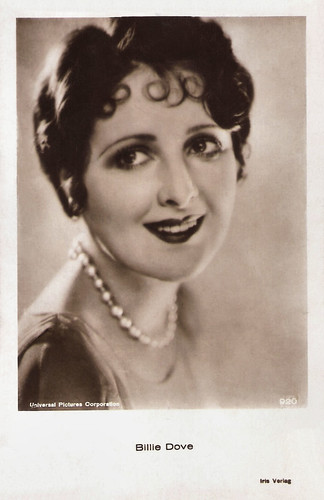
Austrian postcard by Iris Verlag, no. 920. Photo: Universal Pictures Corporation.
Sources: Kevin Brownlow (The Independent), Gary Brumburgh (IMDb), Golden Silents, Wikipedia and IMDb.
This post was last updated on 29 January 2024.

Austrian postcard by Iris-Verlag, no. 5839. Photo: First National-Film.

French postcard by Cinémagazine-Edition, Paris, no. 313.

French postcard by Editions Cinémagazine, no. 626.

German postcard by Ross Verlag, no. 4364/1, 1929-1930. Photo: Defina / First National Pictures. Publicity still for Careers (John Francis Dillon, 1929).

German postcard by Ross Verlag, no. 5166/4, 1930-1931. Photo: First National-Film / Defina.
So lovely yet so shy
Billie Dove was born Bertha Bohny in 1903 in New York to Charles and Bertha (née Kagl) Bohny. Her parents were immigrants from Switzerland. Her brother, Charles, later became a cameraman in Hollywood. Bertha was educated in private schools in Manhattan. Her parents were Lutheran and their church organised sports events; the girls on the basketball team called her "Billie". As a teen, she worked as a model to help support her family.
Kevin Brownlow in his obituary in The Independent: "Billie was an exceptionally beautiful girl, and was in great demand as a model by such eminent artists as Charles Dana Gibson, Howard Chandler Christy and James Montgomery Flagg, who called her 'The Dove' because she was so lovely yet so shy. 'Billie Dove' soon became her professional name."
At age fourteen, she was hired by Florenz Ziegfeld to appear in his Ziegfeld Follies Revue between 1918 and 1920. A neighbour worked as an extra at Fort Lee, across the Hudson from New York City, and Billie's mother had her also registered at the film studios. One of her first appearances was in the Mabel Normand picture Joan of Plattsburg (William Humphrey, George Loane Tucker, 1918).
Billie also served as a dancing replacement in Ziegfeld's Broadway show Sally, (1921) which headlined Marilyn Miller. She legally changed her name to Lillian Bohny in the early 1920s. Gary Brumburgh at IMDb: "A burgeoning affair between Dove and Ziegfeld prompted Ziegfeld's wife Billie Burke to arrange work for the young starlet in Hollywood films."
At age nineteen, Billie had her first Hollywood contract with Metro, where she began appearing in such silent films as the comedy Get-Rich-Quick Wallingford (Frank Borzage, 1921), and Polly of the Follies (John Emerson, 1922), starring Constance Talmadge. Golden Silents: "Billie's roles were mainly decorative in the early years, but female director Lois Weber gave Billie some choicer roles to play in some of her better scripted films for Universal, and director Alexander Korda provided the same for films with First National."

French postcard by J.R.P.R., no. 213. Photo: Metro-Goldwyn. Ben Lyon and Billie Dove in The Tender Hour (George Fitzmaurice, 1927). NB. The film was a First National production, not MGM.

German postcard by Ross Verlag, no. 3217/1, 1928-1929. Photo: Defina / First National. Billie Dove and Lloyd Hughes in An Affair of the Follies (Millard Webb, 1927).

German postcard by Ross Verlag, no. 4726/3, 1929-1930. Photo: Defina / First National. Publicity still for The Stolen Bride (Alexander Korda, 1927).

Austrian postcard by Iris Verlag, no. 5416. Photo: Verleih: Philipp & Co. / First National. Publicity still of Clive Brook and Billie Dove in Yellow Lily (Alexander Korda, 1928).

Austrian postcard by Iris-Verlag, no. 5739. Photo: Verleih Hugo Engel Film / Warner Bros. Publicity still for Adoration (Frank Lloyd, 1928).

French postcard by Europe, no. 622. Photo: Arta-Film / First National. Publicity still for The Man and the Moment (George Fitzmaurice, 1929).
America's most popular actress
Billie Dove had a leading role in All the Brothers Were Valiant (Irvin Willat, 1923) with Malcolm McGregor and Lon Chaney. She married the director of this film, Irvin Willat, in 1923.
Dove was dubbed 'The American Beauty', after her film The American Beauty (Richard Wallace, 1927), and at the end of the 1920s she was voted, with Clara Bow, as America's most popular actress. She appeared opposite Douglas Fairbanks in the smash hit Technicolour film The Black Pirate (Albert Parker, 1926), and played Rodeo West in The Painted Angel (Millard Webb, 1929). She transitioned to sound pictures smoothly and First National extended her contract. Multi-talented Billie was also a singer, a poet, a painter, and an aeroplane pilot. She had a huge legion of male fans, including the then 22-years-old multi-millionaire industrialist, movie producer and aviation enthusiast Howard Hughes.
Kevin Brownlow: "In 1930, in one of the most extraordinary transactions in Hollywood history, Hughes paid Willat $325,000 in thousand-dollar bills to give Billie a divorce. 'I begged Howard not to,' said Billie Dove, 'but there was nothing I could do once he gave the money to Irvin. I felt like I'd been bought and sold.'" She had a three-year romance with Hughes and was engaged to marry him, but she ended the relationship without ever giving cause. Billie Dove cited in The Independent: "It had nothing to do with any man and nothing to do with any woman - it was really such a tiny thing that you wouldn't believe it if I told you."
Hughes is said to have regarded her as the love of his life and they remained on friendly terms. He cast her in his films The Age for Love (Frank Lloyd, 1931), an embarrassing flop, and Cock of the Air (Tom Buckingham, 1932). The Hays Office found the latter too risque and insisted on savage and damaging cuts, and this film flopped as well. Her last film was Blondie of the Follies (Edmund Goulding, 1932) with Marion Davies.
In 1933, she married wealthy rancher and real estate developer Robert Alan Kenaston, a marriage that lasted for 37 years. The couple divorced in 1970 and he died three years later. The couple had a son, actor Robert Alan Kenaston, Jr., who was married to actress Claire Kelly, and an adopted daughter, Gail. In 1934, Dove retired from the screen to raise her family.
Aside from an unbilled bit part of a nurse in Diamond Head (Guy Green, 1963) with Charlton Heston, Dove never returned to the cinema. In the 1970s, Billie had a brief third marriage to architect John Miller, which ended in divorce. She spent her retirement years in Rancho Mirage before moving into the Motion Picture & Television Country House and Hospital in Woodland Hills, California where she died of pneumonia on New Year's Eve 1997, aged 94.

French postcard by Europe, no. 317. Photo: Mercure Film.

German postcard by Ross Verlag, no. 1865/1, 1927-1928. Photo: Fanamet / First National.

German postcard by Ross Verlag, no. 3476/6, 1928-1929. Photo: Defina / First National.

German postcard by Ross Verlag, no. 3687/1, 1928-1929. Photo: Defina / First National Pictures.

German postcard by Ross Verlag, no. 4364/2, 1929-1930. Photo: Defina / First National Pictures.

German postcard by Ross Verlag, no. 4726/2, 1929-1930. Photo: Defina / First National Pictures.

Austrian postcard by Iris Verlag, no. 920. Photo: Universal Pictures Corporation.
Sources: Kevin Brownlow (The Independent), Gary Brumburgh (IMDb), Golden Silents, Wikipedia and IMDb.
This post was last updated on 29 January 2024.
No comments:
Post a Comment